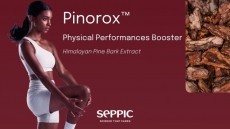Combination of ginger and V. negundo may help alleviate low back pain

“E-PR-01 significantly improved low back pain and bending flexibility in adults without adverse effects,” the authors wrote in the Journal of Back and Musculoskeletal Rehabilitation. “Moreover, the effect of E-PR-01 lasted 7 days after stopping the intervention.”
The blend of Vitex negundo, commonly referred to as Chinese or five-leaved chaste tree, leaves and Zingiber officinale (ginger) rhizome showed an improvement in functional ability, work productivity and functional activity.
Synergy for pain relief
V. negundo has been previously studied for its anti-inflammatory, antioxidant, anti-diabetic and antimicrobial activity. In rats, it has shown pain relieving properties and the potential to inhibit transforming growth factor.
Z. officinale, rich in polyphenols, has demonstrated a potential to reduce oxidative stress and inflammation and provide pain relief for joint conditions. It has also been shown to preserve joint health in osteoarthritis models. The authors of this study sought to understand the synergistic effects, if any, between the two extracts for alleviating low back pain.
According to the World Health Organization, low back pain affected roughly 619 million people in 2020—a 60% increase from 1990—and is expected to affect close to 843 million people by 2050.
Study details
The study recruited 72 participants between the ages of 18 and 60 years who reported non-specific back pain for no longer than 12 months but at least 7 weeks and who spent at least one-third of their awake time in a physically inactive state. Subjects in the supplement group consumed two 200 mg supplements containing the extracts daily for 30 days.
The supplemented group showed improvements in functional disability, bending flexibility, work productivity, sleep quality, pain intensity and functional activity. While participants in the placebo group showed improvement for some of these outcomes, improvements in the supplemented groups were typically two to three times greater. For example, both groups showed improvements in sleep quality, but the supplemented group had twice the improvement, reducing the group from sub-threshold levels to clinically insignificant levels.
“Chronic back pain has been associated with lower quality of life,” the researchers wrote. “In addition to its remarkable effect on pain and functional activity, E-PR-01 has shown a significant effect on forward bending flexibility, work productivity and sleep quality. Improvement in these outcomes can be attributed to the synergistic anti-inflammatory effect of the unique combination, which could help decrease pro-inflammatory markers…”
Source: Journal of Back and Musculoskeletal Rehabilitation
doi: 10.3233/BMR-230197
“Effect of E-PR-01 on non-specific low back pain in the adult population: A randomized, double-blind, placebo-controlled, parallel-group trial”Authors: Srivastava, S., et al.
















